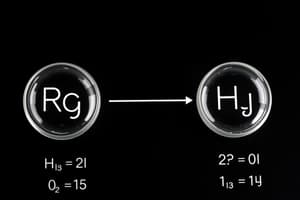Podcast
Questions and Answers
In a chemical reaction, how does the concept of the limiting reactant affect the amount of product formed?
In a chemical reaction, how does the concept of the limiting reactant affect the amount of product formed?
- The limiting reactant has no impact on the amount of product formed, as product formation depends only on the excess reactants.
- The limiting reactant increases the rate at which the product is formed, but not the overall quantity.
- The limiting reactant determines the _maximum_ amount of product that can be formed. (correct)
- The limiting reactant dictates the _minimum_ amount of product that can be formed.
What information is necessary to convert from grams of a reactant to moles of a product using stoichiometry?
What information is necessary to convert from grams of a reactant to moles of a product using stoichiometry?
- The molar mass of the product and the percent yield of the reaction.
- The density of the reactant, the volume of the reaction vessel, and the reaction temperature.
- The molar mass of the reactant, the balanced chemical equation, and the molar mass of the product. (correct)
- The pressure of the system, the universal gas constant, and the temperature in Kelvin.
A chemist calculates the theoretical yield of a reaction to be 25.0 grams. After performing the reaction, they isolate 19.0 grams of the product. What is the percentage yield for this reaction?
A chemist calculates the theoretical yield of a reaction to be 25.0 grams. After performing the reaction, they isolate 19.0 grams of the product. What is the percentage yield for this reaction?
- 86.0%
- 66.0%
- 76.0% (correct)
- 96.0%
In a balanced chemical equation, what do the stoichiometric coefficients represent?
In a balanced chemical equation, what do the stoichiometric coefficients represent?
Consider the balanced equation: 2H₂ + O₂ → 2H₂O. If you have 4 moles of $H₂$ and 2 moles of $O₂$, which reactant is the limiting reactant?
Consider the balanced equation: 2H₂ + O₂ → 2H₂O. If you have 4 moles of $H₂$ and 2 moles of $O₂$, which reactant is the limiting reactant?
Which of the following is NOT a reason why the actual yield of a reaction might be less than the theoretical yield?
Which of the following is NOT a reason why the actual yield of a reaction might be less than the theoretical yield?
A compound is found to have the empirical formula $CH_2O$. Which of the following could be its molecular formula?
A compound is found to have the empirical formula $CH_2O$. Which of the following could be its molecular formula?
What principle is stoichiometry primarily based on?
What principle is stoichiometry primarily based on?
In the balanced chemical equation $2A + 3B \rightarrow C + 4D$, what is the mole ratio of reactant A to product D?
In the balanced chemical equation $2A + 3B \rightarrow C + 4D$, what is the mole ratio of reactant A to product D?
Which step is NOT typically involved in solving stoichiometry problems?
Which step is NOT typically involved in solving stoichiometry problems?
If 1 mole of an ideal gas at STP occupies 22.4 liters, what volume would 0.25 moles of the same gas occupy under the same conditions?
If 1 mole of an ideal gas at STP occupies 22.4 liters, what volume would 0.25 moles of the same gas occupy under the same conditions?
A solution is prepared by dissolving 4 grams of $NaOH$ (molar mass = 40 g/mol) in water to make 500 mL of solution. What is the molarity of the solution?
A solution is prepared by dissolving 4 grams of $NaOH$ (molar mass = 40 g/mol) in water to make 500 mL of solution. What is the molarity of the solution?
For the reaction $N_2 + 3H_2 \rightarrow 2NH_3$, if you start with 6 moles of $N_2$ and 12 moles of $H_2$, which is the limiting reactant?
For the reaction $N_2 + 3H_2 \rightarrow 2NH_3$, if you start with 6 moles of $N_2$ and 12 moles of $H_2$, which is the limiting reactant?
In a reaction, the theoretical yield of a product is 25.0 grams, but the actual yield is 20.0 grams. What is the percentage yield?
In a reaction, the theoretical yield of a product is 25.0 grams, but the actual yield is 20.0 grams. What is the percentage yield?
Given the reaction $2CO(g) + O_2(g) \rightarrow 2CO_2(g)$, if 5 liters of $CO$ react completely with $O_2$, what volume of $CO_2$ is produced at the same temperature and pressure?
Given the reaction $2CO(g) + O_2(g) \rightarrow 2CO_2(g)$, if 5 liters of $CO$ react completely with $O_2$, what volume of $CO_2$ is produced at the same temperature and pressure?
If you have 10.0 g of both reactants A and B, and the reaction is $A + 2B \rightarrow AB_2$, to determine the limiting reactant, you must...
If you have 10.0 g of both reactants A and B, and the reaction is $A + 2B \rightarrow AB_2$, to determine the limiting reactant, you must...
In chemical synthesis, why is stoichiometry crucial?
In chemical synthesis, why is stoichiometry crucial?
Which application of stoichiometry is most relevant in determining the concentration of pollutants in a water sample?
Which application of stoichiometry is most relevant in determining the concentration of pollutants in a water sample?
Flashcards
Stoichiometry
Stoichiometry
The study of quantitative relationships between substances in physical changes or chemical reactions.
Empirical Formula
Empirical Formula
The simplest whole-number ratio of atoms in a compound.
Molecular Formula
Molecular Formula
The actual number of atoms of each element in a molecule.
Mole (mol)
Mole (mol)
Signup and view all the flashcards
Molar Mass
Molar Mass
Signup and view all the flashcards
Stoichiometric Coefficients
Stoichiometric Coefficients
Signup and view all the flashcards
Limiting Reactant
Limiting Reactant
Signup and view all the flashcards
Percentage Yield
Percentage Yield
Signup and view all the flashcards
Mole Ratio
Mole Ratio
Signup and view all the flashcards
Steps for Stoichiometry
Steps for Stoichiometry
Signup and view all the flashcards
Molar Volume at STP
Molar Volume at STP
Signup and view all the flashcards
Molarity (M)
Molarity (M)
Signup and view all the flashcards
% Yield
% Yield
Signup and view all the flashcards
Mass-to-Mass Calculations
Mass-to-Mass Calculations
Signup and view all the flashcards
Mass-to-Volume Calculations
Mass-to-Volume Calculations
Signup and view all the flashcards
Volume-to-Volume Calculations
Volume-to-Volume Calculations
Signup and view all the flashcards
Limiting Reactant Problems
Limiting Reactant Problems
Signup and view all the flashcards
Study Notes
- Stoichiometry is the study of quantitative relationships or ratios between two or more substances undergoing a physical change or chemical reaction.
- It's a vital tool for chemists, allowing them to calculate the amounts of reactants and products involved in chemical reactions.
- It's based on the law of conservation of mass, which states that matter cannot be created or destroyed in a chemical reaction.
Key Concepts in Stoichiometry
- Chemical Formulas: Represent the types and numbers of atoms in a molecule.
- Empirical Formula: The simplest whole-number ratio of atoms in a compound.
- Molecular Formula: The actual number of atoms of each element in a molecule.
- The mole (mol) is the SI unit for the amount of a substance.
- One mole contains exactly 6.02214076 × 10^23 elementary entities (Avogadro's number).
- The molar mass of a substance is the mass of one mole of the substance, expressed in grams per mole (g/mol). It's numerically equal to the substance's atomic or molecular weight.
- Balanced Chemical Equations: Represent chemical reactions and must be balanced to obey the law of conservation of mass.
- Balancing involves adjusting the coefficients in front of the chemical formulas to ensure that the number of atoms of each element is the same on both sides of the equation.
- Stoichiometric Coefficients: The numbers in front of the chemical formulas in a balanced equation.
- They represent the relative number of moles of each reactant and product involved in the reaction.
- Limiting Reactant: The reactant that is completely consumed in a chemical reaction.
- It determines the maximum amount of product that can be formed.
- Excess Reactant: The reactant(s) present in a greater quantity than necessary to react with the limiting reactant.
- Theoretical Yield: The maximum amount of product that can be formed from a given amount of limiting reactant, assuming perfect reaction conditions.
- Actual Yield: The amount of product actually obtained from a chemical reaction. It's often less than the theoretical yield due to factors such as incomplete reactions or loss of product during purification.
- Percentage Yield: The ratio of the actual yield to the theoretical yield, expressed as a percentage. Calculated as: (Actual Yield / Theoretical Yield) x 100%
Mole Ratios
- Mole ratios are derived from the coefficients of the balanced chemical equation.
- They are used to convert between moles of one substance and moles of another substance in a chemical reaction.
- For the balanced equation aA + bB → cC + dD, the mole ratio between A and B is a/b, between A and C is a/c, and so on.
Steps for Solving Stoichiometry Problems
- Balance the Chemical Equation: Ensure that the equation is balanced correctly.
- Convert Given Amounts to Moles: Convert the given masses or volumes of reactants or products to moles using their molar masses.
- Use the Mole Ratio: Use the stoichiometric coefficients from the balanced equation to determine the mole ratio between the substances of interest.
- Calculate Moles of Desired Substance: Use the mole ratio to calculate the number of moles of the desired product or reactant.
- Convert Back to Desired Units: Convert the moles of the desired substance back to the desired units (e.g., grams, liters) using the molar mass or density.
Stoichiometry with Gases
- At Standard Temperature and Pressure (STP: 0°C and 1 atm), one mole of any ideal gas occupies 22.4 liters (molar volume).
- Use the ideal gas law (PV = nRT) to calculate the volume, pressure, temperature, or number of moles of a gas involved in a reaction.
Stoichiometry with Solutions
- Molarity (M) is a common unit of concentration, defined as the number of moles of solute per liter of solution (mol/L).
- Use the formula: Molarity (M) = Moles of Solute / Liters of Solution
- When dealing with solutions, use molarity as a conversion factor between volume and moles.
Limiting Reactant Determination
- Convert the mass of each reactant to moles.
- Divide the number of moles of each reactant by its stoichiometric coefficient in the balanced equation.
- The reactant with the smallest value is the limiting reactant.
Percentage Yield Calculation
- Calculate the theoretical yield of the product based on the amount of the limiting reactant.
- Determine the actual yield of the product from experimental data.
- Calculate the percentage yield using the formula: % Yield = (Actual Yield / Theoretical Yield) * 100
Common Stoichiometry Problem Types
- Mass-to-Mass Calculations: Given the mass of one substance, calculate the mass of another substance involved in the reaction.
- Mass-to-Volume Calculations: Given the mass of a substance, calculate the volume of another substance (usually a gas) involved in the reaction.
- Volume-to-Volume Calculations: Given the volume of one gas, calculate the volume of another gas involved in the reaction (at the same temperature and pressure).
- Limiting Reactant Problems: Determine the limiting reactant and calculate the amount of product formed.
- Percentage Yield Problems: Calculate the percentage yield of a reaction given the actual and theoretical yields.
Practical Applications of Stoichiometry
- Chemical Synthesis: Calculating the correct amounts of reactants needed to synthesize a desired compound.
- Industrial Processes: Optimizing chemical reactions to maximize product yield and minimize waste.
- Environmental Chemistry: Determining the amounts of pollutants released in a chemical process.
- Pharmaceutical Industry: Calculating the dosage of a drug based on its concentration and the patient's weight.
- Analytical Chemistry: Determining the composition of a substance through quantitative analysis.
Studying That Suits You
Use AI to generate personalized quizzes and flashcards to suit your learning preferences.
Description
Explore the quantitative relationships in chemical reactions. Stoichiometry is essential for calculating reactant and product amounts. It relies on the law of conservation of mass and utilizes concepts like chemical formulas and the mole.




